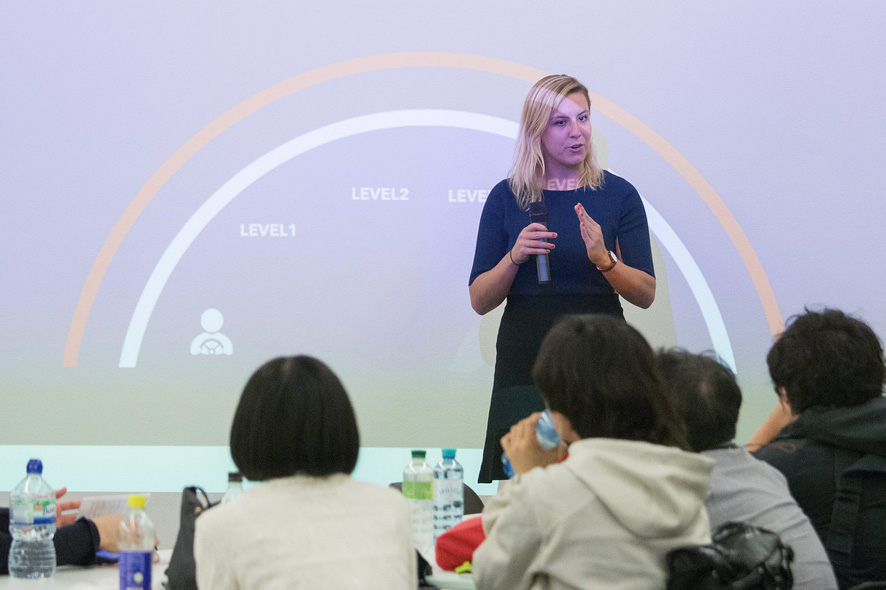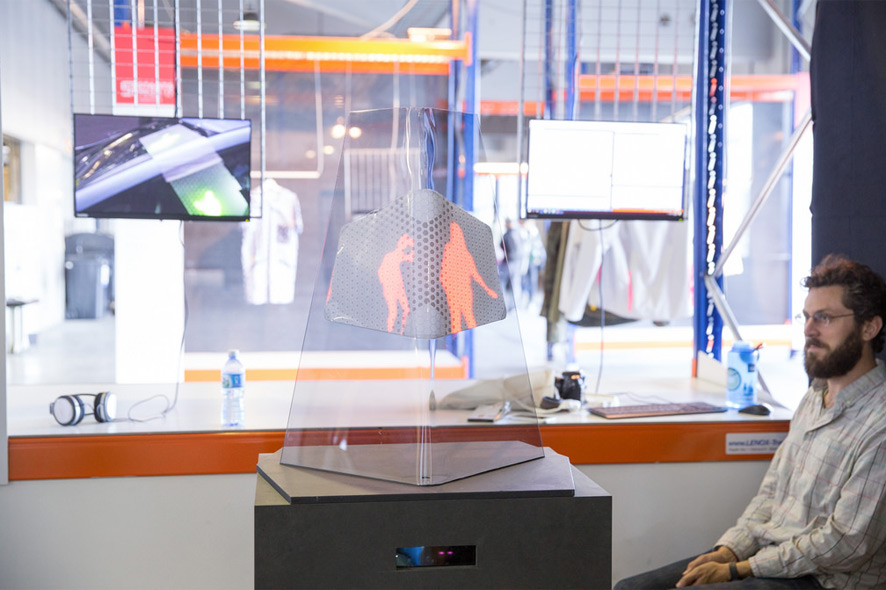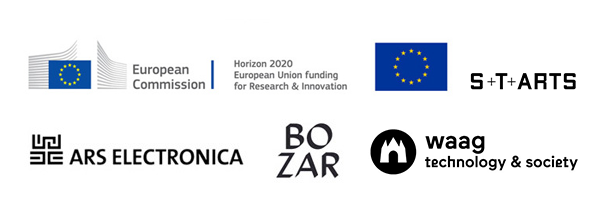The STARTS Prize exhibition at the 2017 Ars Electronica Festival, “Blink: Humanising Autonomy” by Adam Bernstein, Raunaq Bose, Leslie Nooteboom and Maya Pindeus, proposes new ways to facilitate interaction among driverless autonomous vehicles and pedestrians. Blink’s approach is for humans and machines to use gestures and light signals to communicate their respective intentions to one another. We talked to Maya Pindeus about the project, which 2017 STARTS Prize recognition launched on its way to becoming a London-based company.

Maya Pindeus at the STARTS Prize Talks / 2017 Ars Electronica Festival. Credit: Tom Mesic
How did you come up with the idea? And how did you turn it into reality?
Maya Pindeus: We believe that the interaction between humans and autonomous systems in the city of the future is one of the biggest challenges of our time. We started by exploring how we could make the urban environment a more pleasant and comfortable place for people to live in, while looking at emerging technologies, such as Autonomous vehicles. We quickly realized that our position, and our values, seemed to be at odds with what was being shown by many of the automotive industry’s concepts of autonomous cars in our future cities; and that a new, human-centered approach to autonomy was needed.
We believe that while infrastructure exists to balance the power between pedestrians and vehicles, much of the current infrastructure was built around the needs of the vehicle. Aside from the potential of autonomous vehicles to cause far less accidents and fatalities in the urban environment, their arrival also provides an opportunity to rebalance the road power dynamics and give pedestrians an equal weighting in the city.
This is why we developed a prototype that allows for two-way interaction between pedestrians and an autonomous vehicle. Our prototype created a machine learning algorithm that allows a pedestrian to communicate its intent to the vehicle through hand gestures and allows the vehicle to detect and understand human intent. The prediction algorithm was based on a dataset collected on the streets of London.
“Our aim was to create technology that adapts and fits to what is natural for people to do and develops intuitive interactions between human and machine rather than the other way round.”
What will be the challenges in human communication with autonomous cars, drones, and other moving things in public spaces?
Maya Pindeus: Cities are dense and crowded and unexpected things happen and change within a split second. It is very challenging yet important for an autonomous car and any autonomous system in general, to be able to understand the full range and diversity of human behavior in cities in order to be able to accurately communicate with them. Lack of trust and societal acceptance for autonomous technology is also one of the main barriers to autonomous vehicle development. We think that is very important to develop interactions and communication with autonomous systems that feel natural and intuitive to us humans and fit to our behaviors on the street.

“Blink: Humanising Autonomy” at the STARTS Prize exhibition of 2017 Ars Electronica Festival. Credit: Florian Voggeneder
What has happened after your 2017 STARTS Prize Honorary Mention? How did you enhance your project and where did you show it?
Maya Pindeus: 2017 was an exciting year for us, as it marked the start of our company Humanising Autonomy. Last fall, after exhibiting at 2017 Ars Electronica Festival, , we were invited to join the DART17 accelerator in San Francisco where we spent some time developing our business and technology and even had a talk at NASA. We are now based in London, where we are developing our technology – a platform that allows autonomous vehicles to understand and predict human intent and we are collaborate with the automotive industry on pilot projects. We recently started a collaboration with Daimler Mercedes Benz. Next month we are invited to hold a panel on our human centered approach to autonomous technology at SXSW together with Daimler and Dart17. We are always looking for new projects and partnerships and we are also growing and looking for people that want to join us on developing natural interactions with autonomous systems.
Last but not least: What do you think are the main benefits of a collaboration in the fields of science, technology and arts?
Maya Pindeus: Technology can never be viewed as an isolated process. It always needs to be embedded into a discourse and the wider context of society. People need to be able to trust, understand and relate to it. Interdisciplinary work creates a unique opportunity to explore the different manifestations of technology with a critical eye. Collaborations between science, arts and technology create a unique environment that allows for different viewpoints, nourish experimentation and never forget about the bigger picture.
If you have an innovative project that’s based on interaction among science, technology and art, you’re cordially invited to vie for a STARTS Prize awarded by the European Union! The entry deadline is March 2, 2018. Two grand prize recipients will each receive €20,000. Details are available at starts-prize.aec.at!
The idea behind Blink: Humanising Autonomy comes from a cross-disciplinary team of four masters students of the Innovation Design Engineering MA/MSc Programme at the Royal College of Art and Imperial College London: Adam Bernstein (US) has a background in Electrical Engineering, with experience in the foundation of electric vehicle infrastructure. Raunaq Bose (UK) has a background in Mechanical Engineering, with experience in bringing products from the conceptual stage to market. Leslie Nooteboom (NL) has a background in Industrial Design Engineering, with experience in robotics and the building of a solar-powered racecar. Maya Pindeus (AT) has a background in Architecture, with experience in human-machine interactions.
This project has received funding from the European Union’s Horizon 2020 research and innovation programme under grant agreement No 732019. This publication (communication) reflects the views only of the author, and the European Commission cannot be held responsible for any use which may be made of the information contained therein
